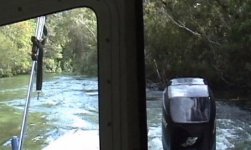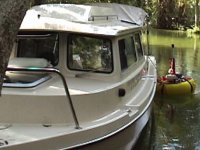Hi Guys!
When installing my heater (Force 10 Cozy Cabin, propane powered) the summer before last, I went through the same questions about heat distribution. Where I live, in Northern California, about 28 degrees is usually the bottom end temperature encountered most of the time, and I usually sleep on the converted dinette berth, so insulating the v-berth wasn't a priority with me.
I did consider setting up a blower to force warm air from above the heater into the v-berth, however, and after some thought, decided it would be more difficult than another alternative.
My thinking is that to force warm air from the top of the cabin down into the v-berth would be difficult without a fairly strong (and noisy) blower unit that would not only deliver the air to the forward area, but also mix it up thoroughly, as the warm air would otherwise just rise up to the top of the forward cabin from the mouth of the tube and follow the cabin roof back to the main cabin ceiling, leaving much of the area cold. A strong fan would forcefully do the job of thoroughly mixing the warm and cold air, but I wanted to use one or two small computer CPU fan motors that could be run all night with negligible power drain.
What I decided would work more easily was to use two such fans and a tube system to pump the coldest air in the cabin from the main floor area up through the galley cabinet and onto the hot surface of the heater and become heated. As the fans progressively remove the cold air from the floor, the warm air that collects at the ceiling level gradually grows in volume, and soon the bottom boundary (a thermocline) of that warm air descends to the floor as all the air becomes heated. In this way, we're not using the fan power as a forced air furnace delivery system, but instead using it to eliminate the cold air at the bottom of the heated chamber and letting the warmed air distribute itself naturally. In the process, cold dense air in the v-berth flows outward to the cabin floor naturally and is replaced by warm air entering from the main cabin area.
It does, of course, take power to lift the cold air up to the hot surface of the heater, but not as much as to have a complete system of forced circulation. I hope this makes sense and is not overly wordy, but wanted to convey the idea thoroughly. In practice it works very well, and I seldom use the 3,000 / 6,000 btu heater on anything other than the lower setting. I also suspect that the heater used with the fan system is able to extract a considerably larger percentage of the heat produced by the flame and is therefore much more efficient.
The two fans are 0.17 amps each, and used over a 10 hour period only use 3.4 amp hours of current, which has negligible affect on two 105 amp hour deep cycle batteries.
If necessary, one could also boost the warm air flow into the v-berth area with a tube and small similar fan system, pushing warm air from the main cabin through a tubed passageway through the cabin bulkhead to assist the heat flow into this area. Another small fan would have little additional affect on electrical current consumption. A bigger problem would be where and how to route the tube, as the helm/dash/bulkhead is pretty busy already and esthetic considerations would also be important.
Hope this helps your thinking regarding installing a complete heating system. Photos of my heater installations are in the Library under Cabin Interior Photos with test explanations. Nice visiting with you. Joe.



